| Article ID | Journal | Published Year | Pages | File Type |
|---|---|---|---|---|
| 5134619 | Journal of Analytical and Applied Pyrolysis | 2017 | 14 Pages |
â¢Coupling biogas plants with HTC systems can be a solution for handling digestate.â¢At high temperatures, hydrothermal carbonization leads to thermally stable chars.â¢Digestate hydrochars can be converted into adsorbents with large surface areas.â¢Hydrochars with high carbon content are needed for obtaining high micropore volumes.â¢Activated carbons from digestate can successfully separate CO2 from methane.
Digestate from a biogas plant that uses solely biomass for biogas production was used as precursor material for the production of activated carbon as an alternative to increase its added value. The digestate was converted into hydrochar by hydrothermal carbonization varying the temperature (190-250 °C), residence time (3 and 6 h), and pH (5 and 7). Temperature followed by residence time had the strongest influence on the chemical composition and thermal stability of the hydrochars. A significant effect of the pH was not observed. The hydrochars were chemically activated to enhance the surface area and use them as activated carbon. As a consequence, the surface areas increased from 8 to 14 m2/g (hydrochars) to 930-1351 m2/g (activated carbons). Furthermore, large micropore volumes were measured (0.35-0.50 cm3/g). The activated carbons were studied as adsorbents in gas phase applications, showing that the product of digestate is a very effective adsorbent for carbon dioxide (CO2). Especially the activated carbon obtained from the hydrochar produced at 250 °C for 6 h, which adsorbed 8.80 mol CO2/kg at 30 °C and 14.8 bar. Additionally, the activated carbons showed a stronger affinity towards CO2 compared to methane (CH4), which makes this material suitable for the upgrading of raw biogas to biomethane.
